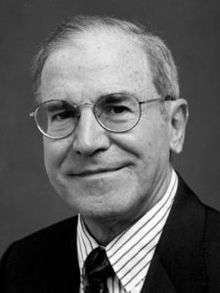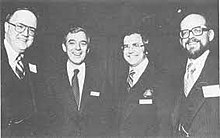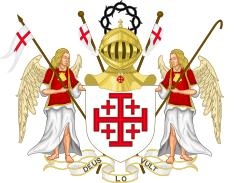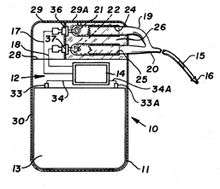Anthony Adducci
Anthony J. Adducci (August 14, 1937 – September 19, 2006) was a pioneer of the medical device industry in Minnesota.[1] He is best known for co-founding Cardiac Pacemakers, Inc., the company that manufactured the world's first lithium battery powered artificial pacemaker[2]. The lithium-iodide cell is now the standard cell for pacemakers, having the energy density, low self-discharge, small size and reliability needed.
Anthony J. Adducci | |
|---|---|
 | |
| Born | August 14, 1937 |
| Died | September 19, 2006 (aged 69) |
| Resting place | Resurrection Cemetery, Mendota Heights, Minnesota |
| Nationality | Italian American |
| Other names | A.J., Tony |
| Education | 1959 BS Physics at Saint Mary's University of Minnesota |
| Occupation | Inventor and entrepreneur |
| Known for | Co-founding Cardiac Pacemakers, Inc., the company that manufactured the world's first lithium battery powered artificial pacemaker. |
| Spouse(s) | Sandra Gordon |
Early life and education
Adducci was born in Chicago, Illinois on August 14, 1937. In 1951, he graduated from St. Catherine of Genoa Grammar School, in the Roseland neighborhood of Chicago. He attended Saint Mary's University of Minnesota receiving the BS Physics in 1959. He pursued additional study in electrical engineering at Illinois Institute of Technology and in business administration at the University of Minnesota.
Career
In 1960, Adducci was employed as an acoustical engineer for the Jensen Manufacturing Company in Chicago, Illinois where he engaged in the design and development of loudspeakers and horns.
In 1961, he joined International Telephone and Telegraph Corporation in Chicago Illinois where, as a development engineer, he instructed numerous training courses on digital data communication systems and as a senior test engineer directed ITT personnel in electro-interference testing of the Boeing Minuteman (missile) for the Strategic Air Command. He also taught hi-level courses to the United States Air Force in Biloxi, Mississippi.
While in Chicago in 1963, Adducci worked with a local physician and developed an electronic ear thermometer used to detect the time of ovulation in the human female. He developed a little earplug and a recording device that would measure the tympanic temperature and got his wife, who was a nurse, to measure her temperatures, and they were able to predict ovulations. They published a paper in an IEEE journal (Institute of Electrical and Electronics Engineers) biomedical area.
In August 1964, he accepted a position with the Sperry Rand Corporation's UNIVAC Division in St. Paul, Minnesota as a system design engineer engaged in the logic design of computer peripheral equipment.
In April 1966, he joined Medtronic as a Sales Engineer. Adducci was the ninetieth employee at the time. While at Medtronic he served in various technical and marketing responsibilities including, sales administration manager, and pacemaker consulting specialist. He taught surgeons around the United States in the basics of how pacemakers work, the physiology of the cardiovascular system and the instructions to insert the pacemaker into the body. Adducci was involved in over fifty surgeries while at Medtronic.
In February 1972, he co-founded Cardiac Pacemakers, Inc.(CPI) of St. Paul, Minnesota. CPI was a highly successful start up venture, going from zero sales in 1972 to over $47 million and highly profitable when it was acquired by Eli Lilly and Company in 1978 for $127 million.

In August 1998 he became the Commander of the Maricopa County Sheriff's Office Community Service Posse in Arizona.
Personal
Adducci was married to Sandra Gordon, had three children: Michael, Brian, and Alicia. He has six grandchildren.
Death
Adducci died in Scottsdale, Arizona on September 19, 2006, of Multifocal motor neuropathy at the age of 69.
Board of directors
- Catholic Charities of the Archdiocese of St. Paul/Minneapolis
- Trustee of Saint Mary's University of Minnesota.
- Development Committee of the North American College of Rome
- Health Advisory Council of the College of St. Catherine in St. Paul, Minnesota
- Deltec in Arden Hills (founding director)
- Medical Graphics in Vandais Heights (founding director)
- Dimensional Medicine in Minnetonka (founding director)
- Delphax in Minnetonka (founding director)
- CAPSULE design in Minneapolis (founding director)
- North American Banking Companies (founding director)
Charity
Adducci founded The Adducci Family Foundation. A Charitable foundation with special interest in child abuse, battered woman and special educational programs for the elderly.
Honors
- Induction into the Minnesota Science and Technology Hall of Fame [3]

- Knight Grand Cross of the Order of the Holy Sepulchre of Jerusalem [4]
- Knight in the Order of Malta.
- Commander of the Maricopa County Sheriff's Office Community Service Posse.
- 2nd degree black belt in Tae Kwon Do Karate
- 3rd degree black belt in Aikido and founder of the Minnesota Ki Society.[5]
- St. Mary's University Distinguished Alumnus [6]
Publications
Held Patents

- PT#: 3822707 Metal-Enclosed Cardiac Pacer with Solid-State Power Source - Image Document
- PT#: 3822707 Metal-Enclosed Cardiac Pacer with Solid-State Power Source - Text Document
An improved heart pacer including the conventional combination of a pulse generator, electrode means, and electrode leads coupling the pulse generator to the electrodes, wherein the battery power source of the pulse generator is a solid-state battery with a lithium anode and a lithium-iodide electrolyte.(see Wilson Greatbatch, ed.). The pacer structure is enclosed in a hermetically sealed metallic enclosure, with means being provided in the enclosure for passing electrode leads in sealed relationship therethrough. The outer surface of the casing is polished metal*, and is continuous in all areas. In certain instances, the continuity may be with the exception of the zone through which the external electrode leads pass.
*In the patent claim the term polished metal * was used as an all-encompassing description. The initial commercial artificial pacemaker, under the patent in 1972, used stainless steel as a non-hermetic encasing medium. Continuing research led to use of the more biologically compatible titanium in a welded hermetically sealed pacemaker in 1976.
References
- "Pioneers of the Medical Device Industry". Minnesota Historical Society.
- , "Metal-enclosed cardiac pacer with solid-state power source", issued 1974-05-08
- "Minnesota Historical Society: Anthony J. Adducci | Pioneers of the Medical Industry in Minnesota". Mnhs.org. Retrieved 2020-03-01.
- "Holy Sepulchre History". Sleohs.com. Retrieved 2020-03-01.
- "The Center for Mind-Body Oneness". Mindbodyoneness.com. 2020-01-01. Retrieved 2020-03-01.
- http://mysmumn.org/s/1400/index.aspx?sid=1400&gid=1&pgid=462
- Larson, R.; Adducci, A. (1961). "Transient distortion in loudspeakers". IRE Transactions on Audio. 9 (3): 79–85. doi:10.1109/TAU.1961.1166317. ISSN 2168-2984. PMID 14288259.
- Adducci, A. J.; Weidenkopf, T. E.; Garwacki, D. J. (1965). "Ovulation Detection by Internal Cranial Temperature Measurements". IEEE Transactions on Biomedical Engineering. 12 (1): 2–7. doi:10.1109/TBME.1965.4502334. ISSN 1558-2531. PMID 14288259.
- , "Herzschrittmacher", issued 1973-01-13